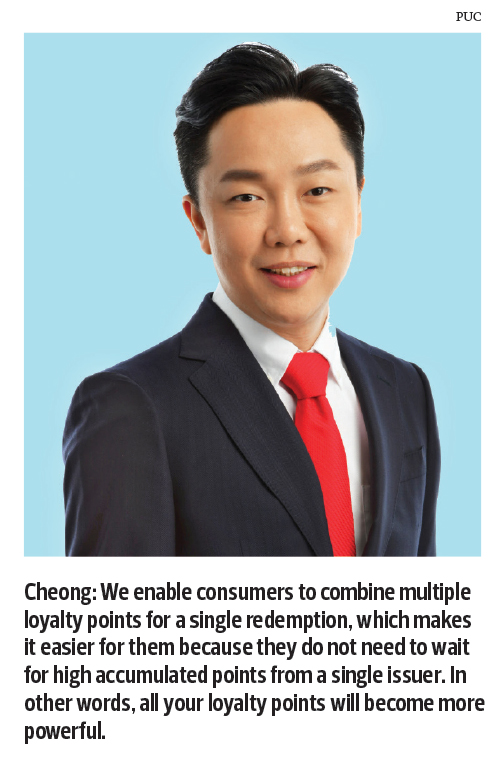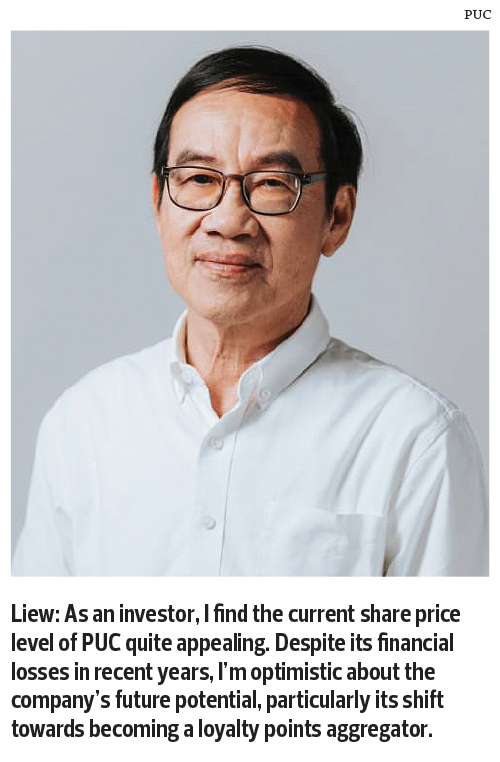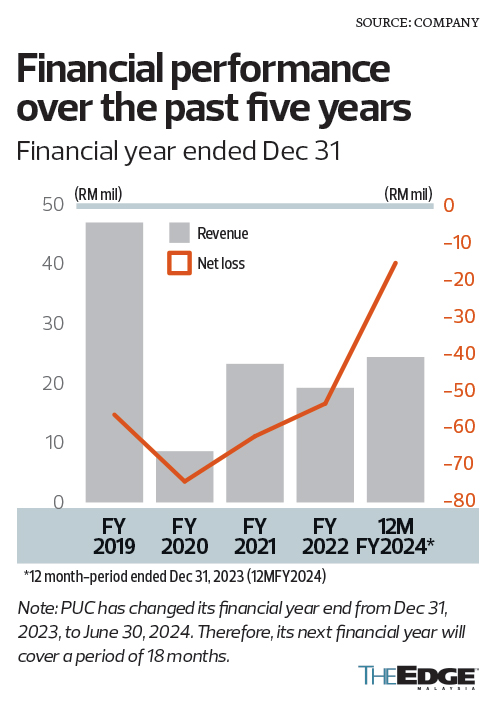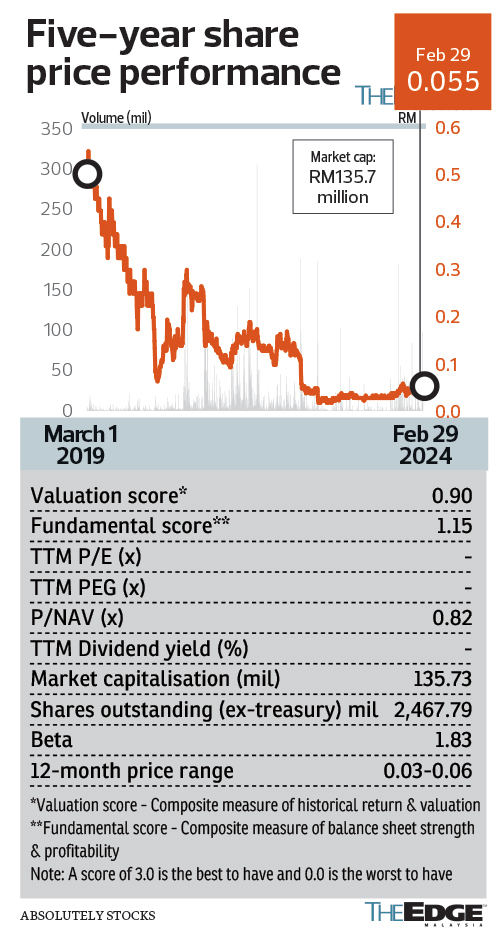This article first appeared in The Edge Malaysia Weekly on March 4, 2024 - March 10, 2024
AFTER ACE Market-listed PUC Bhd failed to obtain a digital bank licence in April 2022, its group managing director Cheong Chia Chou found himself at a crossroads. While disappointed, Cheong knew he needed to refocus on the company’s online shopping site — Presto Mall (formerly known as 11Street).
Having given serious thought to the plan for over a year, Cheong decided to venture into the provision of loyalty e-commerce redemption solutions and be a loyalty points aggregator. This would help to attract “footfall” to Presto Mall, which is not doing too well, judging by its financial performance.
The major breakthrough came last November, when it was announced that PUC would team up with e-wallet operator TNG Digital Sdn Bhd to offer redemption services for the latter’s loyalty programme, GOrewards.
Besides TNG Digital, PUC is also collaborating with Grab, Boost, EZ-Link, Plus Miles, BonusLink, Shell and AmBank.
Meanwhile, the group is in discussions to rope in an insurance company, a stockbroker, an airline, an airport lounge operator, a resort operator and a few banks.
In an interview with The Edge, Cheong explains that loyalty points are broken up or divided into smaller pieces across different programmes or platforms, which makes them less useful or valuable overall.
“Conventionally, loyalty points are only collected via a single channel from loyalty issuers, and consumers usually find it hard to accumulate enough points to redeem something meaningful. And when customers can’t find anything interesting to redeem, they lose interest and there is no longer value to these loyalty points.
“Now, our idea is to revolutionise the landscape of loyalty rewards programmes through points combined with e-commerce redemption. We are offering an innovative platform where loyalty points become a digital currency, merging with e-commerce redemption,” he explains.
Cheong points out that it is common for large companies that have a recurring service to issue loyalty points in order to keep customers in their ecosystem. However, these companies are constantly facing challenges in attracting consumers to their loyalty programmes.
“As a result, multiple variances of solutions are created in the market, such as direct to cashback, which defeats the original purpose of having to issue loyalty points [as] consumers do not see the value and just treat it as a straight-off discount. It will be a price war for these companies,” he elaborates.
By enabling consumers to redeem products with a combination of multiple points at its e-commerce redemption platform Presto, which offers more than 20,000 products and services, PUC will solve the problems of loyalty issuers, consumers and merchants, says Cheong. “We enable consumers to combine multiple loyalty points for a single redemption, which makes it easier for them because they do not need to wait for high accumulated points from a single issuer. In other words, all your loyalty points will become more powerful.”
PUC will take a cut from the merchants on products redeemed.
When contacted, the former president of a credit card issuing company who declined to be named appears to be sceptical about the viability of a loyalty points aggregator business model. “The success of such a model would depend on the monetary value of these loyalty points. If the value is just too low, consumers may not find it worthwhile to go through the hassle of combining points from different programmes or platforms. After all, time is money,” he says.
The two challenges, according to the former executive, are whether consumers are willing to share their data with an aggregator, and whether the big merchants are keen to participate in such a programme. “Again, this programme can only work if the monetary value is attractive enough to incentivise consumers to accumulate these loyalty points and take the extra step to combine them. And the thing is, if the monetary value is high enough, most customers would likely prefer to redeem the rewards directly from the issuers themselves, rather than through an aggregator.”
Chua Zhu Lian, group managing director of Vision Group, which operates offshore variable capital company funds in Singapore, believes PUC’s concept is “brilliant from a consumer’s standpoint” to maximise value.
However, the business execution and comprehensiveness of PUC’s e-commerce ecosystem would be the major deciding factors in its long-term sustainability as a loyalty points aggregator.
“Such business concepts and models would face resistance from more established and cash-rich point-based incumbents, including e-commerce heavyweights such as Lazada and Shopee, as well as the high cost of customer acquisition, which is typical for tech companies piloting a new tech and concept.
“Nevertheless, should PUC succeed with its concept, it would be able to achieve first-mover advantage while further expanding the user base for its entire ecosystem,” he comments.
Interestingly, former confectionery tycoon Liew Fook Meng and his brother Lau Pak Lam had, at end-January, emerged as new substantial shareholders in the group, setting the stage for the return of the co-founders of Cocoaland Holdings Bhd to the public-listed arena of corporate Malaysia.
What does Liew see in PUC?
“Since I exited Cocoaland, I’ve been searching for the right companies to invest in. To be honest, I don’t know much about the technology business. But as an investor, I find the current share price level of PUC quite appealing,” Liew tells The Edge. “Despite its financial losses in recent years, I’m optimistic about the company’s future potential, particularly its shift towards becoming a loyalty points aggregator.”
Over the past 12 months, PUC’s stock price had gained just one sen to five sen last Wednesday, giving it a market capitalisation of RM113.11 million.
Liew believes in the principle of buying low when a company shows signs of a turnaround, rather than buying at the peak when performance is already strong. “Buying shares is essentially buying the future of a company. To me, it is not too important how a company performed in previous years, but it is more important to predict how it will perform in the coming years.”
He had on Jan 26 acquired 241.549 million shares or a 9.78% direct stake in PUC off-market, while Lau had on the same day mopped up 232 million shares, raising his equity interest in the company to 238 million shares or a 9.64% stake. Four days later, Lau bumped up his equity interest to 248 million shares or a 10.05% stake. The two brothers now collectively own a 19.83% stake.
Proven Venture Capital PLT, which subscribed to 185.87 million new shares or a 7.85% stake via PUC’s private placement exercise in October last year, offloaded its entire block of shares off-market on Jan 26, ceasing to be a substantial shareholder. Proven Venture is jointly owned by more than 100 limited partners consisting of high-net-worth entities and individuals.
Notably, Genting Plantations Bhd is a substantial shareholder of PUC with a 6.59% stake, while Cheong has 6.41% equity interest.
PUC’s net loss narrowed to RM15.42 million in the 12 month-period ended Dec 31, 2023 (12MFY2024), as compared to RM53.56 million in the financial year ended Dec 31, 2022 (FY2022). As the company had changed its financial year-end to June 30, 2024, its FY2024 will cover a period of 18 months.
Liew is confident that the business model will work and he is optimistic that PUC will do well in the next three to five years. “Personally, I love the loyalty points business because it benefits all consumers and merchants. But for the longest time, consumers have been facing one problem, they have too many fragmented loyalty points from various merchants.
“That’s why I like PUC’s idea to become the first loyalty points aggregator in Malaysia, making these fragmented loyalty points more valuable,” he adds.
Cheong’s efforts to revive the online shopping site are much needed in order to make the company profitable. To effectively execute the strategy, PUC’s online shopping platform needs to have a wide variety of merchants in order to draw the crowd. Moreover, given the fierce competition in the borderless online market, it is crucial to adopt a business model that focuses on customer needs and preferences, while also leveraging innovative marketing strategies to differentiate the platform from its competitors.
Save by subscribing to us for your print and/or digital copy.
P/S: The Edge is also available on Apple's App Store and Android's Google Play.
- China vows ‘fight to the end’ on tariffs as it props up markets
- Trump’s long game: America’s president may be betting on forever
- Malaysian stocks slip again as trade tension worries linger
- Patchy gas restoration raises stability concerns; firms lean on alternatives
- Frustrated world leaders wonder if Trump even wants a deal
- Alibaba chases international AI users with new Qwen upgrades
- Asian gas falls to one-year low as trade war stokes demand fears
- Australia April consumer confidence slammed by tariff turmoil
- Chinese stocks bounce back as state funds come to the rescue
- UK says London City Airport can go ahead with expansion plan





